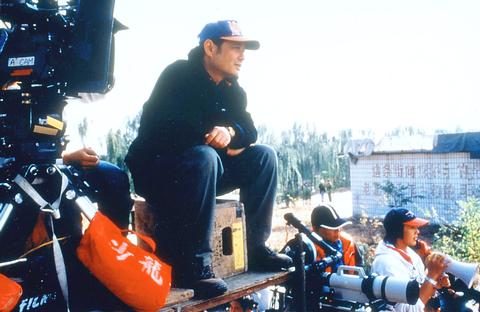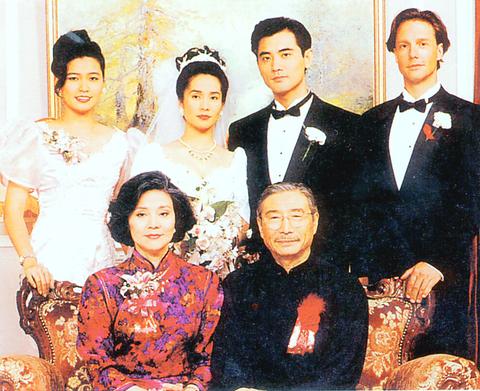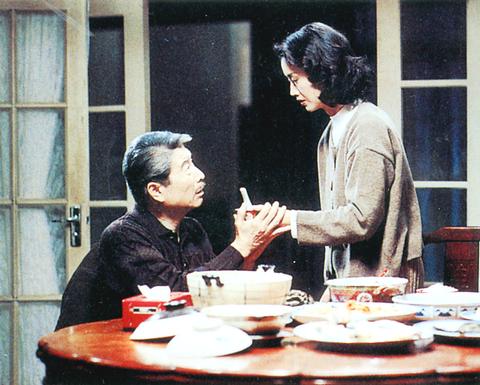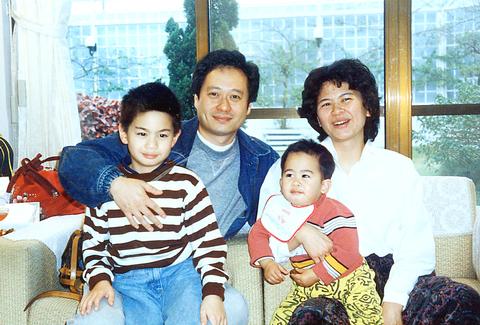"Ang Lee's (李安) personality is very often reflected in his films," said producer Hsu Li-kong (徐立功), Lee's long-term filming partner.
Indeed, the main character in the film Pushing Hands (推手) bears a distinct resemblence to the then 39-year-old filmmaker, at the time a new hand in the business.

PHOTO COURTESY OF NEW ACTION ENTERTAINMENT
Before Pushing Hands, Lee had spent six years homebound waiting sullenly for film projects in up-state New York. But he kept up hope and patience, much like the elderly figure in the film, who lives with an American household and is confined to the house with virtually nothing to do and who, out of boredom, takes up tai chi (太極拳), the breathing exercises that focus physical and inner strength.

PHOTO COURTESY OF NEW ACTION ENTERTAINMENT
Ten years on, Lee's movies have evolved from the lugubrious Pushing Hands to the fantastical martial arts megahit Crouching Tiger, Hidden Dragon (臥虎藏龍). Themes of waiting and endurance have been replaced with those of romance and anxiety. And the action has diversified from the glacially paced tai-chi movements to bombastic flying, hacking and sword dancing.
The biggest change in Lee's life is likely to take place tomorrow (Los Angeles time) at the 73rd Anual Academy Awards ceremony, where Crouching Tiger is up for 10 different Oscars, including best director and picture.

PHOTO COURTESY OF NEW ACTION ENTERTAINMENT
Crouching Tiger is the first foreign-language film to break the US$100 million mark at the US box office and has triggered considerable hype over an "Asian film invasion."

PHOTO COURTESY OF NEW ACTION ENTERTAINMENT
However, like most artists, Lee has his own hidden agenda in making the film aside from commercial achievement.
"Everybody has his own inner dragon inside the heart. It can be an unforgettable love, or a dream of ancient China... Making this film has fulfilled my childhood fantasy and also helped me deal with my mid-life crisis," Lee said when accepting the Golden Globe Award as for best director recently.

PHOTO: NI YOU-CHUN, LIBERTY TIMES
Hong Kong star Chow Yun-fat (周潤發), who plays protagonist Li Mu-bai in Crouching Tiger, was probably the first one to expose Lee's authorial intervention in the movie. "As you know, Li Mu-bai is Ang Lee," Chow said at the film's HK premiere.
In Lee's previous films, especially in his "Father knows Best" family dramas, the leading male role is typically a well-intentioned, yet bumbling and fundamentally clueless figure. In Crouching Tiger, however, Lee seems to have sloughed off the awkward charm of his previous characters and jumped into the skin of a sword-wielding, love-tormented martial arts hero juggling the affections of two heroines.
Lee admits that the film was probably the first time he dealt with desire and anxiety.
"In Taoism, dragon and tiger symbolize emotions and desires, respectively. One must tame the dragon and the tiger to vanquish desire, so that one can achieve the Tao," Lee has said in describing the film.
Li Mu-bai faces just such a dilemma in the film. On one hand he represses feelings for Yu Siu-lien (Michelle Yeoh, 楊紫瓊), while on the other he lectures the wild and petulant Jen (Zhang Ziyi, 章子怡). At the same time though, he feels the tug of desire for both.
The women in Crouching Tiger emerge with the strongest characters: the tough, calm, rational Yu Siu-lien and the daring, willful and brilliant Jen. The two roles, according to Lee, were inspired by his wife. "My wife's personality is more like Siu-lien. But she also has a bold and rebellious side, as in Jen's character," said Lee.
Lee is quick to hand credit to his wife, Lin Hui-chia (
"She is very independent, and decisive, whereas I am more irresolute. In our house, she sets the rules and I follow," Lee has been quoted as saying.
During a Q&A session at Crouching Tiger's US release, Lee again let down his guard: "I'm more interested in tough women. Maybe because I'm not very macho, so fragile women don't usually intrigue me."
Crouching Tiger was also a chance for Lee to give expression to his fantasies about ancient China and martial arts and dabble in the stock techniques of the kung fu genre. He mixes stunning long and close shots in the first fight scene, as Yu Siu-lien and Jen run up and down walls and jump from roof to roof. He transforms a bamboo grove into a poetic battlefield in which the actors fight on the top end of bamboo stalks. And through clever use of wires, he makes the actors defy gravity.
"Learning to shoot a martial arts film was a lot of fun," Lee said in an interview in Taipei at the Golden Horse Awards. "Before, I have been like a good student when making films, being careful at every step. Now after the experience of Crouching Tiger, I would like to take bigger strides in the future," he said.
Indeed, five weeks ago Lee just finished a US$2 million five-minute BMW commercial which involves a high-speed car chase. Lee is clearly in the film industry's big league now. No wonder his wife likes to tease him by saying, "whatever he couldn't achieve in his childhood, he can now try to achieve with his films."

May 11 to May 18 The original Taichung Railway Station was long thought to have been completely razed. Opening on May 15, 1905, the one-story wooden structure soon outgrew its purpose and was replaced in 1917 by a grandiose, Western-style station. During construction on the third-generation station in 2017, workers discovered the service pit for the original station’s locomotive depot. A year later, a small wooden building on site was determined by historians to be the first stationmaster’s office, built around 1908. With these findings, the Taichung Railway Station Cultural Park now boasts that it has

Wooden houses wedged between concrete, crumbling brick facades with roofs gaping to the sky, and tiled art deco buildings down narrow alleyways: Taichung Central District’s (中區) aging architecture reveals both the allure and reality of the old downtown. From Indigenous settlement to capital under Qing Dynasty rule through to Japanese colonization, Taichung’s Central District holds a long and layered history. The bygone beauty of its streets once earned it the nickname “Little Kyoto.” Since the late eighties, however, the shifting of economic and government centers westward signaled a gradual decline in the area’s evolving fortunes. With the regeneration of the once

In February of this year the Taipei Times reported on the visit of Lienchiang County Commissioner Wang Chung-ming (王忠銘) of the Chinese Nationalist Party (KMT) and a delegation to a lantern festival in Fuzhou’s Mawei District in Fujian Province. “Today, Mawei and Matsu jointly marked the lantern festival,” Wang was quoted as saying, adding that both sides “being of one people,” is a cause for joy. Wang was passing around a common claim of officials of the People’s Republic of China (PRC) and the PRC’s allies and supporters in Taiwan — KMT and the Taiwan People’s Party — and elsewhere: Taiwan and

Even by the standards of Ukraine’s International Legion, which comprises volunteers from over 55 countries, Han has an unusual backstory. Born in Taichung, he grew up in Costa Rica — then one of Taiwan’s diplomatic allies — where a relative worked for the embassy. After attending an American international high school in San Jose, Costa Rica’s capital, Han — who prefers to use only his given name for OPSEC (operations security) reasons — moved to the US in his teens. He attended Penn State University before returning to Taiwan to work in the semiconductor industry in Kaohsiung, where he